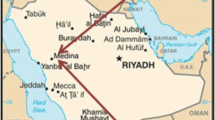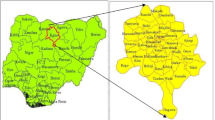Abstract
The present study aims to assess natural radioactivity and its radiological hazards and dose parameters in granite waste samples. These wastes arise through uranium chemical leaching, then they were scrutinized by gamma ray spectrometry (HPGe detector) the concentration of U-238 samples ranged between (556 and 1479) Bq/kg, Th-232 ranged between (18 and 690) Bq/kg, Ra-226 samples ranged between (911and 2269) Bq/kg and K-40 ranged between (461 and 675) Bq/kg. Radon daughter and airborne dust are safe. The annual effective dose equivalent was 0.2 mSv/y. In conclusion we recommended reusing these waste in paving roads in open places.


Similar content being viewed by others
References
IAEA (2013) Measurement and calculation of radon releases from NORM residues, Technical Reports Series No. 474. International Atomic Energy Agancy, Vienna, Austria
IAEA (2015) Protection of the public against exposure indoors due to radon and other natural sources of radiation, IAEA safety standrard series No. SSG-32. International Atomic Energy Agency, Austria, Vienna
Sethy NK, Jha VN, Sutar AK (2014) Assessment of naturally occurring radioactive materials in the surface soil of uranium mining area of Jharkhand, India. J Geochem Explor 142:29–35. https://doi.org/10.1016/j.gexplo.2013.11.009
Nagasaki S, Nakayama S (2015) Radioactive waste engineering and management. Springer, Tokyo
IAEA. (2018) Regulatory Control of Radioactive Discharge To The Environment general safety guide No. GSG-9. International Atomic Energy Agency, Vienna
Mahmoud KF, Kamal HM, Shehata MR, Hosny WM, Mohamed Mohamed Omar HA (2020) Leaching kinetics of uranium from Playa deposits at Atmur El-Kibeish area, South Western Desert Egypt. Int J Environ Anal Chem. https://doi.org/10.1080/03067319.2020.1849650
Khawassek M (2016) Kinetics of leaching process using sulfuric acid for sella Uranium ore material, south eastern desert Egypt. Int J Nuclear Energy Sci Eng 6:62–73
IAEA. (2020) Occupational Radiation Protection in the Uranium Mining and Processing Industry, safety reports series No. 100. International Atomic Energy Agency, Austria, Vienna
IAEA. (2003) Extent of environmental contamination by naturally occurring radioactive material (NORM) and technological options mitigation, Technical Report Series No. 419. International Atomic Energy Agency, Vienna
Mubarak F et al (2017) Radiological investigation of high background radiation Areas. Sci Rep. https://doi.org/10.1038/s41598-017-15201-2
Haggag EA (2013) Kinetics of leaching process of Uranium from EL-Missikat shear zone Eastern Desert Egypt. J Basic Environ Sci 1:65–75
UNSCEAR (2000) Sources and effects of ionizing radiation, united nations scientific committee on the effects of atomic radiation, annex B: exposures from natural radiation sources, vol I. United Nations Publications, New York
IAEA (1976) Manual on Radiological Safety in Uranium and Thorium Mines and Mills, safety series, vol 43. International Atomic Energy Agency, Vienna
Essa AM (2016) Occupational radiation dose estimation over radioactive waste of phosphoric acid purification and ore products projects. Phosphor Acid Purificat J Basic Environ Sci 3:74–84
ICRP (1986) Radiation Protection of Workers in Mines. ICRP Publication 47. Ann. ICRP 16.
IAEA (2004) Radiation Protection against Radon in Workplaces other than Mines, Safety Reports Series, vol 33. IAEA, Vienna
Beck.H.L.(1972)The physics of environmental radiation fields. Natural radiation environment"a II,CONF-720802: p2- Proceeding of the second International Symposium on the Natural radiation Environment
Kumar AA, Kumar S, Singh J, Singh P, Bajwa BS (2017) Assessment of natural radioactivity levels and associated dose rates in soil samples from historical city Panipat, India. J Radiat Res Appl Sci 10(3):283–288. https://doi.org/10.1016/j.jrras.2017.05.006
Krieger R (1981) Radioactivity of construction materials. Betonwerk Fertigteil-Technol 47:468–446
Beretka J, Matthew PJ (1985) Natural radioactivity of australian building materials industrial waste and byproducts. Health Phys 48:87–95
Cottens. E. (1990) Actions against radon at the international level". In: Proceedings of the Symposium on SRBII, Journee Radon, Royal Society of Engineers and Industrials of Belgium, Brussels
Abdelbary HM, Elsofany EA, Mohamed YT et al (2019) Characterization and radiological impacts assessment of scale TENORM waste produced from oil and natural gas production in Egypt. Environ SciPollut Res 26:30836–30846. https://doi.org/10.1007/s11356-019-06183-x
Senthilkumar RD, Narayanaswamy R (2016) Assessment of radiological hazards in the industrial effluent disposed soil with statistical analyses. J Radiat Res Appl Sci 9(4):449–456. https://doi.org/10.1016/j.jrras.2016.07.002
IAEA (1996) International Basic Safety Standards for Protection against Ionizing Radiation and for the Safety of Radiation Sources, Safety Series, vol 115. International Atomic Energy Agency, Vienna
MaoL DT et al (2014) Preliminary analysis of polonium-210 contamination for China LEAd-based research reactor. Prog Nucl Energy 70:39–42. https://doi.org/10.1016/j.pnucene.2013.07.009
Panigrahi DC et al (2018) Assessment to Rn-222 and gamma exposure of the miners in Narwaphar underground uranium mine, India. Radiat Phys Chem 151:225–231. https://doi.org/10.1016/j.radphyschem.2018.06.042
ICRP (1993) Protection Against Radon-222 at Home and at Work. ICRP Publication 65. Ann. ICRP 23 (2)
Morsi T, Hegazy R, Badawy W (2017) Radiological impact assessment to the environment due to waste from disposal of porcelain. Int J Radiat Bio. https://doi.org/10.1080/09553002.2017.1287453
EC European Commission (1999) Radiological protection principles concerning the natural radioactivity of building materials. Radiation Protection 112, Directorate General Environment. Nuclear Safety and Civil Protection, European Commission
ICRP, 2013. Radiological protection in geological disposal of long-lived solid radioactive waste. ICRP Publication 122. Ann. ICRP 42(3).
UNSCEAR (2008) Sources and Effects of Ionizing Radiation, United Nations Scientific Committee on the Effects of Atomic Radiation. Annex B: Exposures of the Public and Workers from Various Sources of Radiation, vol I. United Nations Publications, New York
Abdel Gawad AE, Ibrahim EM (2016) Activity ratios as a tool for studying uranium mobility at El Sela shear zone, southeastern Desert. Egypt J Radioanal Nucl Chem 308:129–142. https://doi.org/10.1007/s10967-015-4374-0
Okasha SA, Faheim AA, Monged MHE, Khattab MR, Abed NS, Salman AA (2020) Radiochemical technique as a tool for determination and characterisation of El Sela ore grade uranium deposits. Int J Environ Anal Chem. https://doi.org/10.1080/03067319.2020.1863388
Mahmoud SAEA, Abdellah WM, Abu Khoziem HA (2018) Mineralogy, geochemistry and leaching characteristics of the high-grade Th-U-Y zone of altered syenite at El Garra El Hamra, Southwestern Desert Egypt. Min Metall Explor 35:230–240. https://doi.org/10.19150/mmp.8600
Zakia SA, Rashad MM, Mohamed SA, EL Sheikh EM, Mira HE, Abd el Wahab GM (2020) Kinetics of uranium leaching process using sulfuric acid for WadiNasib ore, South western Sinai Egypt. Aswan Univ J Environ Stud (AUJES) 1(2):171–182
Pillai GS, Jeevarenuka K, Hameed PS (2017) Radioactivity in building materials of PuduKkottai geological region, Tamil Nadu. India Earth Syst Environ 1:4. https://doi.org/10.1007/s41748-017-0005-y
Ishmah SN, Permana MD, Firdaus ML, Eddy DR (2020) Extraction of silica from bengkulu beach sand using alkali fusion method. J Sci Educ 4(2):1–5. https://doi.org/10.33369/pendipa.4.2.1-5
Acknowledgements
This project was supported by Scientific Research and Technology (ASRT), Egypt, Grant ASRT is the 2nd affiliation of this research.
Author information
Authors and Affiliations
Corresponding author
Additional information
Publisher's Note
Springer Nature remains neutral with regard to jurisdictional claims in published maps and institutional affiliations.
Rights and permissions
About this article
Cite this article
Essa, A.M., Daher, A.M., Nasr, A.S. et al. Assessment of radiation risk from waste generated from mining and remediation process of granite ore. J Radioanal Nucl Chem 329, 1139–1148 (2021). https://doi.org/10.1007/s10967-021-07864-z
Received:
Accepted:
Published:
Issue Date:
DOI: https://doi.org/10.1007/s10967-021-07864-z




